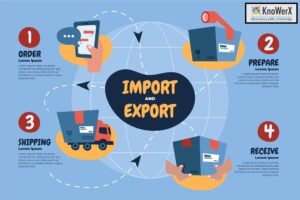Why Supply Chain Transformation is a Must Now – The Complete Guide
Supply chain transformation refers to the comprehensive rethinking and restructuring of supply chain processes, systems, and strategies to better align with the changing demands of the global market. Unlike incremental improvements, transformation entails adopting innovative technologies, reengineering workflows, and reshaping supply chain models to drive long-term resilience and performance.

Since 2020, businesses have faced significant disruptions that exposed the vulnerabilities of traditional supply chain models. From the COVID-19 pandemic to geopolitical tensions and inflationary pressures, these global shocks have underscored the urgent need for businesses to future-proof their supply chains.
In this complete guide, we explore the key reasons driving the transformation, core components of a modern supply chain, step-by-step processes to begin your transformation journey, the challenges involved, real-life case studies, and future trends that will redefine supply chain success.
The Need for Urgency: What’s Changed in Supply Chains
Impact of Global Disruptions: The COVID-19 pandemic brought supply chains to a standstill, causing delays, stockouts, and cost escalations. The Russia-Ukraine war and trade tensions have further strained global networks. These events have demonstrated that supply chains can no longer be reactive; they must be proactive, responsive, and resilient.
Rising Customer Expectations: Today’s consumers expect real-time visibility, faster delivery, and seamless omni-channel experiences. Supply chains must adapt to meet these expectations, ensuring flexibility and transparency across the entire delivery journey.
Regulatory and Sustainability Demands: Governments and regulatory bodies are enforcing stricter environmental, social, and governance (ESG) standards. From carbon emissions reporting to ethical sourcing requirements, organisations must transform their supply chains to comply with new regulations.
Digital Disruption: The acceleration of technology is reshaping how supply chains operate. Companies must embrace digital tools to remain competitive, from cloud computing and big data to machine learning and robotic process automation (RPA).
Key Drivers of Supply Chain Transformation
Demand Volatility and Inventory Visibility: Consumer demand patterns have become unpredictable. Accurate forecasting and inventory visibility are vital for managing stock levels, minimising waste, and ensuring timely fulfilment.
ESG and Sustainability Goals: Organisations are now being held accountable for their environmental impact. Green logistics, waste reduction, and circular supply chain models are no longer optional – they are imperative.
Shift from Globalisation to Regionalisation: Companies are reducing dependence on global suppliers and moving toward regionalised networks to improve supply continuity and reduce risks from geopolitical issues.
Data and Analytics as a Differentiator: Harnessing data enables businesses to identify inefficiencies, predict disruptions, and make data-driven decisions. Predictive analytics and real-time insights offer a significant competitive edge.
Labour Shortages and Skills Gap: The shortage of skilled labour is a growing concern. Businesses must invest in upskilling employees and automating repetitive tasks to maintain operational efficiency.
Core Pillars of a Transformed Supply Chain
Digitalisation & Automation
AI, IoT, Blockchain, and Robotics: Artificial Intelligence (AI) is used for forecasting, automation, and anomaly detection. Internet of Things (IoT) devices enable real-time tracking of goods. Blockchain ensures transparent and tamper-proof record-keeping, while robotics streamline warehouse operations and last-mile delivery.
Resilience & Agility
Scenario Planning, Dual Sourcing, Buffer Stock: Building resilience involves planning for multiple scenarios, diversifying suppliers, and maintaining safety stock. Agility ensures businesses can quickly pivot in response to changes in demand or disruptions.
Customer-Centric Supply Chain
Last-Mile Delivery, Personalisation, Omni-Channel Fulfilment: A modern supply chain is designed around the customer. This includes enabling faster last-mile delivery, offering personalised products and services, and integrating online and offline fulfilment channels.
Data-Driven Decision Making
Advanced Analytics, Real-Time Dashboards: Real-time data visualisation dashboards and predictive analytics help companies anticipate issues, optimise routes, manage inventory, and improve performance across the board.
Sustainability Integration
Green Logistics, Circular Economy, Carbon Reduction: Sustainability is embedded into every layer of a modern supply chain. Companies are adopting electric delivery vehicles, recycling packaging materials, and aiming for net-zero emissions.
Steps to Begin Supply Chain Transformation
Assessment & Benchmarking: Begin with a detailed assessment of your existing supply chain. Benchmark performance against industry standards to identify gaps and opportunities for improvement.
Define Vision and Strategic Objectives: Establish a clear vision for transformation. Align objectives with broader business goals, including efficiency, customer satisfaction, risk mitigation, and sustainability.
Invest in the Right Technology: Choose technologies that align with your strategy. Cloud platforms, ERP systems, AI tools, and automation technologies should be scalable and compatible with your existing infrastructure.
Change Management & Talent Upskilling: Transformation is as much about people as it is about technology. Implement change management strategies and train your workforce to adopt new tools and workflows.
Pilot Programs and Phased Implementation: Test new solutions through pilot projects. Use lessons learned to refine your approach and scale in phases to minimise disruption and maximise ROI.
Challenges to Expect – And How to Overcome Them
![]()
Resistance to Change: Employees may resist new technologies or fear job displacement. Clear communication, involvement in planning, and training can ease transitions.
Integration Issues: Legacy systems can hinder integration. A strong IT strategy, middleware solutions, and API-driven architecture can enable seamless connectivity.
Budget Constraints: Transformation requires investment. Prioritise initiatives with quick wins and high ROI to secure buy-in and justify further funding.
Data Quality and Cybersecurity: Poor data quality leads to poor decisions. Implement data governance policies and cybersecurity protocols to safeguard operations.
Stakeholder Alignment: Ensuring alignment across departments can be challenging. Regular updates, workshops, and cross-functional teams foster collaboration and alignment.
Case Studies: Success Stories in Supply Chain Transformation
Example 1: Walmart
Walmart implemented predictive analytics and IoT technologies to enhance inventory management and customer experience. Their investments have resulted in increased stock availability and reduced waste.
Example 2: Unilever
Unilever embraced a sustainable supply chain by reducing emissions and increasing supply chain transparency. They leveraged blockchain to track materials from source to shelf.
Example 3: DHL
DHL integrated robotics and AI in their warehouses to optimise logistics and improve delivery speed. Their innovation hubs promote continuous improvement and tech adoption.
The Role of Leadership in Driving Change
CEO and CSCO Alignment: Leadership must be united in their commitment to transformation. The CEO and Chief Supply Chain Officer (CSCO) should co-create strategic initiatives and monitor progress together.
Cross-Functional Collaboration: Supply chain transformation impacts all departments. Cross-functional teams ensure that initiatives are aligned, integrated, and supported across the organisation.
Encouraging Innovation and Risk-Taking: Encourage experimentation and innovation. A culture that rewards initiative and calculated risk-taking will thrive in a fast-evolving environment.
Future Trends Shaping the Next-Gen Supply Chain
AI and Machine Learning Evolution: AI will become more sophisticated in demand planning, risk detection, and autonomous decision-making.
Hyperautomation: Combining AI, RPA, and machine learning will drive hyperautomation, reducing manual intervention and improving accuracy.
Autonomous Supply Chain Networks: Self-driving vehicles, drone deliveries, and autonomous planning tools will define the future of supply chains.
Supply Chain-as-a-Service (SCaaS): Outsourcing logistics and supply chain functions to specialised service providers will become more prevalent, offering scalability and expertise.
Frequently Asked Questions
What is supply chain transformation?
Supply chain transformation is the strategic overhaul of supply chain processes, systems, and technologies to improve resilience, efficiency, and adaptability.
Why is supply chain transformation important now?
Global disruptions, rising customer expectations, and regulatory pressures have made it essential for supply chains to be more agile, digital, and resilient.
What are the key drivers of supply chain transformation?
Major drivers include demand volatility, ESG goals, digital disruption, labour shortages, and the shift from global to regional supply networks.
Ending Remark

In today’s rapidly evolving global landscape, supply chain transformation is no longer a choice it’s a strategic imperative. To navigate challenges and stay ahead of the curve, professionals must be equipped with the latest skills, tools, and industry insights. That’s where KnoWerX comes in. With over 33 years of collective experience and a legacy of excellence in education and consultancy, KnoWerX is uniquely positioned to empower individuals and organisations through top-tier Supply Chain Management Training. Our commitment to delivering high-quality, affordable education ensures that you are not only prepared for today’s challenges but also ready to lead tomorrow’s supply chains. Partner with KnoWerX to transform your supply chain journey into a path of continuous growth and success.
Image Reference: Freepik
Disclaimer: All trademarks, logos, and brand names are the property of their respective owners. All company, product, and service names used in this website are for identification purposes only. Use of these names, trademarks, and brands does not imply endorsement.



